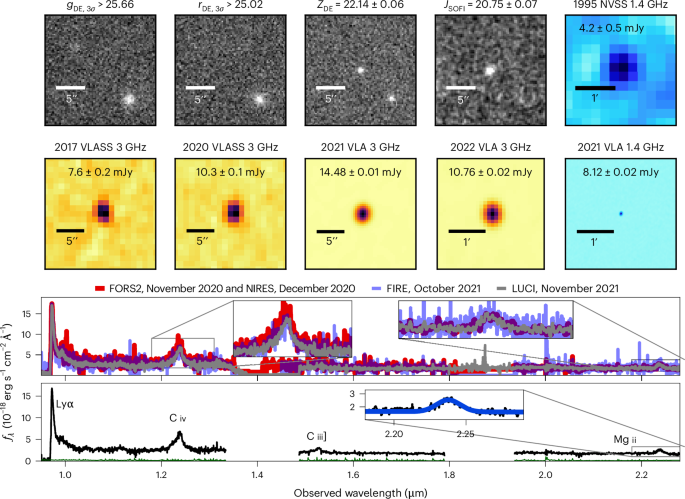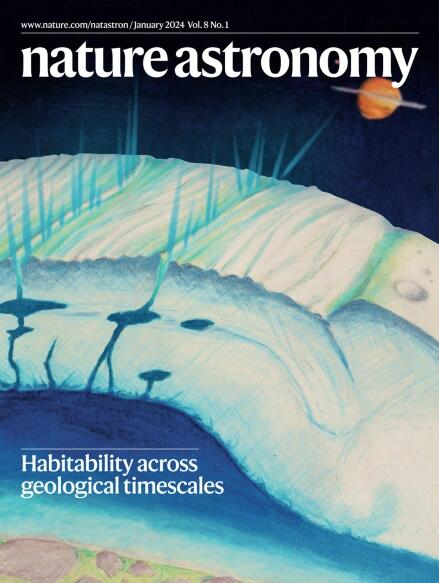A blazar in the epoch of reionization
IF 12.9
1区 物理与天体物理
Q1 ASTRONOMY & ASTROPHYSICS
引用次数: 0
Abstract
Relativistic jets are thought to play a crucial role in the formation and evolution of massive galaxies and supermassive black holes. Blazars, which are quasars with jets aligned along our line of sight, provide insights into the jetted population and have been observed up to redshifts of z = 6.1. Here, we report the discovery and multi-wavelength characterization of the blazar VLASS J041009.05−013919.88 at z = 7 (age of the Universe ~750 Myr), which is powered by a ~7 × 108 M⊙ black hole. The presence of this high-redshift blazar implies a large population of similar but unaligned jetted sources in the early Universe. Our findings suggest two possible scenarios. In one, the jet in J0410−0139 is intrinsically low power but appears highly luminous due to relativistic beaming, suggesting that most ultraviolet-bright quasars at this redshift host jets. Alternatively, if J0410−0139 represents an intrinsically powerful radio source, there should be hundreds to thousands of radio-quiet quasars at z ≈ 7 with properties like those of J0410−0139, a prediction in tension with observed quasar densities based on their ultraviolet luminosity function. These results support the hypothesis that the rapid growth of black holes in the early Universe may be driven by jet-enhanced or obscured super-Eddington accretion, potentially playing a key role in forming massive black holes during the epoch of reionization. The discovery of a distant blazar J0410−0139 at z = 7 suggests that many similar sources existed in the early Universe, supporting the hypothesis that the rapid growth of black holes is driven by jet-enhanced or obscured accretion.


再电离时期的耀变体
相对论喷流被认为在大质量星系和超大质量黑洞的形成和演化中起着至关重要的作用。耀变体是一种类星体,它的喷流沿着我们的视线排列,提供了对喷流星体的深入了解,并被观测到红移z = 6.1。在这里,我们报告了在z = 7(宇宙年龄~750 Myr)处发现的blazar VLASS J041009.05 - 013919.88的多波长特征,它是由一个~7 × 108 M⊙黑洞提供能量的。这个高红移耀变体的存在意味着在早期宇宙中存在大量类似但未对齐的喷射源。我们的发现提出了两种可能的情况。其中之一是,J0410−0139中的喷流本质上是低功率的,但由于相对论光束而显得非常明亮,这表明在这种红移的类星体中,大多数紫外线明亮的类星体都有喷流。或者,如果J0410−0139代表了一个本质上强大的射电源,那么在z≈7处应该有成百上千个具有类似J0410−0139性质的无线电安静类星体,这是基于观测到的类星体密度基于它们的紫外线光度函数的预测。这些结果支持了一个假设,即早期宇宙中黑洞的快速增长可能是由喷流增强或被遮挡的超级爱丁顿吸积驱动的,这可能在再电离时期形成大质量黑洞的过程中起着关键作用。
本文章由计算机程序翻译,如有差异,请以英文原文为准。
求助全文
约1分钟内获得全文
求助全文
来源期刊

Nature Astronomy
Physics and Astronomy-Astronomy and Astrophysics
CiteScore
19.50
自引率
2.80%
发文量
252
期刊介绍:
Nature Astronomy, the oldest science, has played a significant role in the history of Nature. Throughout the years, pioneering discoveries such as the first quasar, exoplanet, and understanding of spiral nebulae have been reported in the journal. With the introduction of Nature Astronomy, the field now receives expanded coverage, welcoming research in astronomy, astrophysics, and planetary science. The primary objective is to encourage closer collaboration among researchers in these related areas.
Similar to other journals under the Nature brand, Nature Astronomy boasts a devoted team of professional editors, ensuring fairness and rigorous peer-review processes. The journal maintains high standards in copy-editing and production, ensuring timely publication and editorial independence.
In addition to original research, Nature Astronomy publishes a wide range of content, including Comments, Reviews, News and Views, Features, and Correspondence. This diverse collection covers various disciplines within astronomy and includes contributions from a diverse range of voices.
 求助内容:
求助内容: 应助结果提醒方式:
应助结果提醒方式:


